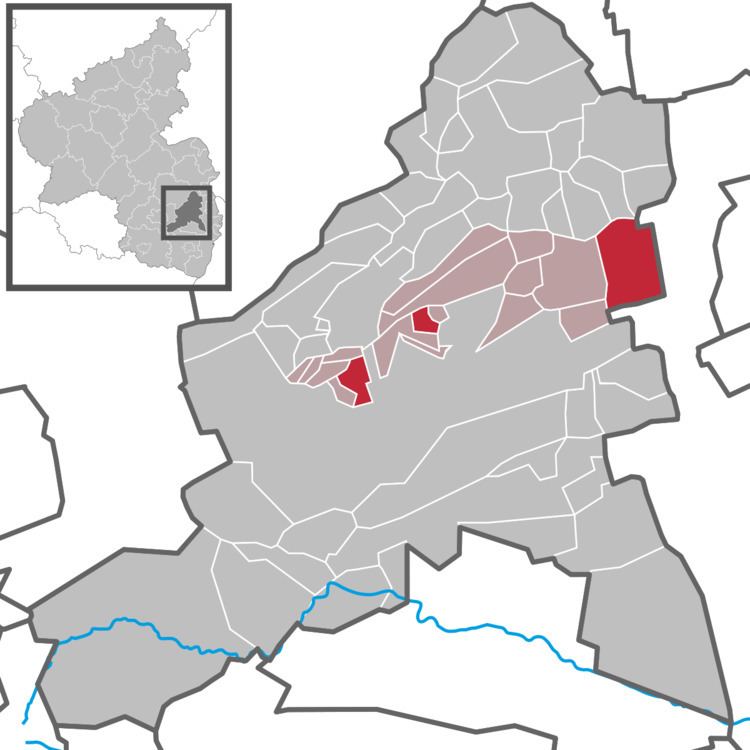Time zone CET/CEST (UTC+1/+2) Area 13.72 km² Postal code 67256 | Elevation 98 m (322 ft) Postal codes 67256 Local time Monday 12:12 AM Dialling code 06353 | |
 | ||
Weather 11°C, Wind S at 8 km/h, 67% Humidity | ||
Weisenheim am Sand (Palatine German: Weisrem) is an Ortsgemeinde – a municipality belonging to a Verbandsgemeinde, a kind of collective municipality – in the Bad Dürkheim district in Rhineland-Palatinate, Germany.
Contents
- Map of Weisenheim am Sand Germany
- Location
- Climate
- History
- Municipal council
- Mayor
- Coat of arms
- Town partnerships
- Education sport and leisure
- Famous people
- References
Map of Weisenheim am Sand, Germany
Location
Weisenheim am Sand lies in the Upper Rhine Plain in the Eastern Palatinate (Vorderpfalz). Through Weisenheim flows the Fuchsbach, which empties into the Isenach in Frankenthal. Within the village’s limits is the neighbouring recreational area “Käschdeberg”. By both land area and population, Weisenheim am Sand is the biggest village in the Verbandsgemeinde of Freinsheim (whose seat is in the like-named town), to which the smaller municipality of Weisenheim am Berg also belongs.
Climate
The area around Weisenheim is believed to be one of Germany’s mildest regions and is particularly suited to winegrowing and fruitgrowing.
History
Friedrich Schiller got his silver sand from Weisenheim to dry his ink.
Municipal council
The council is made up of 20 council members, who were elected at the municipal election held on 7 June 2009, and the honorary mayor as chairman.
The municipal election held on 7 June 2009 yielded the following results:
Mayor
The mayor is Dieter Helt (CDU), and the first deputy is Wilfried Weber (FWG).
Coat of arms
The German blazon reads: In Rot ein aufrecht gestellter goldener Palmzweig, beseitet von zwei sechsstrahligen goldenen Sternen.
The municipality’s arms might in English heraldic language be described thus: Gules a palm frond palewise, the leaves bendwise sinister, between two mullets of six, all Or.
The arms go back to the village’s oldest known seal, from 1474. The palm frond stands for Saint Cyriacus, the local patron, but what the mullets (star shapes) mean is unknown. The arms have been borne since 1922 but were officially granted only on 19 August 1957.
Town partnerships
Weisenheim am Sand fosters partnerships with the following places:
Education, sport and leisure
Weisenheim has three kindergartens and a primary school with four levels each with two classes. To the school belongs the community gymnasium. The municipal library, meanwhile, has moved from the town hall to the ground floor of the primary school.
The biggest sport club is SV Weisenheim am Sand. Other sport clubs are ASV Weisenheim am Sand, Tennis-Club Ludwigshain (TCL) and the Schützengilde Weisenheim am Sand (“Marksmen’s Guild”). Among other clubs are the Reit-und Fahrverein Weisenheim (riding and driving), the volunteer fire brigade’s promotional club, the local history and museum club and several Fastnacht groups.
Famous people
Living in Weisenheim are the Austrian competition horseman Hugo Simon, who in 1996 was the world’s "most successful show jumper", and also the former FIFA referee and now Südwestdeutscher Fußballverband ("Southwest German Football League") functionary Werner Föckler (b. 24 June 1945).
